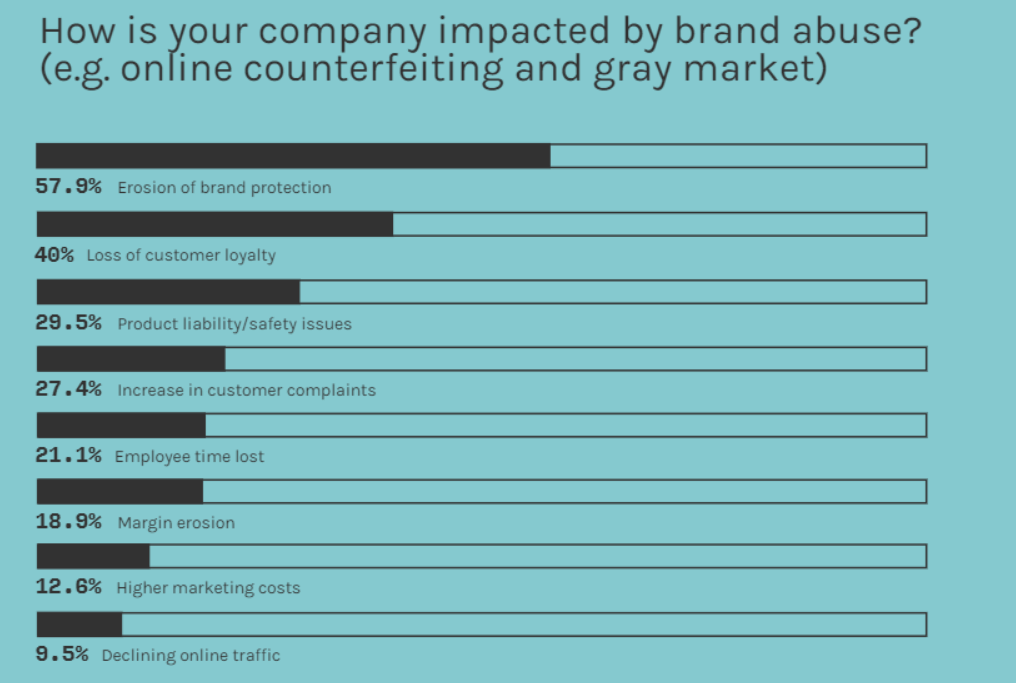
Table of Contents:
Last updated on: September 29, 2022
When considering brand erosion, the most common topic that springs to mind is a brand’s counterfeits. However, the threats to brands are diversifying. New ways of undercutting their hard-earned reputation have emerged. The Brand Intelligence Index details the predictions of industry experts, giving actionable insights into what brands should be watching out for in the coming year.
It’s no surprise that the biggest impact for brands is still related to counterfeiting. Large-scale counterfeit networks are predicted to have the most impact on the erosion of brand value. However, coming at a close second is Gray market selling; One in three IP experts think that the gray market industry will be one of the biggest factors in eroding brand value in the coming year. The market that has been somewhat overlooked by brands now looks to be a major influence on how brands evolve.
Summary:
Check out other IP trends from the Brand Intelligence Index:
For consumers, the gray market often goes unnoticed and unknown. Legitimate, well-designed gray market websites guarantee product authenticity, proving this as much as they can to differentiate themselves from the better-known black market counterfeits. And they can do so with complete freedom, as selling these products poses no legal threat to them.
So consumers think they’re getting the best of both worlds: their favorite brand at slashed prices. These products can be found as much as 50% cheaper on gray market websites than what the brand is officially selling them for. Disappointment hits consumers hard upon realizing their favorite brand does not support their authentic product in after-sales services. They’ve made sure to buy authentic, this factor comes as a big negative surprise to most consumers.
The issue here is that gray market products are sold without a warranty, as official sellers are the only ones able to issue these. So when the product needs repair, the brand cannot support them for lack of a warranty. It seems very harsh in a consumer’s perspective to find there’s no support from the brand they love. Consumers are lured into buying from the gray market due to a lack of clarity on what it entails.
The lack of after-sales support leads to brand-lovers becoming detractors, which can have strong negative impacts on a brand’s image. The fact that a consumer’s unsatisfied voice can be heard across social media can pose a major threat for brands. From writing directly under a brand’s newest post about their lack of after-sales support, to consumers posting on their own profile to inform all their peers about their disappointment. The public has no perspective on the issue that’s related to the gray market product, it’s seen as a direct complaint about the brand.
In our latest market research on Brand Intelligence, industry experts saw this market as the second biggest threat for a series of reasons; 40% said that companies affected by brand abuse receive a loss in customer loyalty. Gray market sellers may be good at striking a sale, but their objective is short-term: making one-off sales to the unsuspecting consumer. They don’t care what their customer’s experience is after that. The gray market is a complete mystery to most consumers, they fall into the discount trap much more confidently than with counterfeits.
This cleverly-named market is a complicated one for brands to address as the gray market is not illegal, making it tricky to enforce upon. The products are authentic, it’s the brand’s own sellers that are to blame for the goods arriving at the hands of gray market sellers.
A brand’s official reseller that gets tied down with unwanted stock may turn to the quick and easy option of selling it to a gray market seller. It’s hard for brands to get visibility on this issue without using tracking software technology. Brands are left with a blind spot. Without any knowledge of how much these items are being sold for nor to which country, which deeply deteriorates their brand value.

Some brands have spent colossal amounts of money into rebuying their own stock found on the gray market in order to try and counteract the effects of brand erosion. The luxury watch market has taken a big hit; 20% of searches of watches online were for gray market watches. It’s no surprise that it is the second biggest trend to shape 2020 for IP professionals, according to our Brand Intelligence Index report.
Every issue that brands encounter in relation to brand abuse points to a cut in their revenue in the long run. When asked about brand abuse, 18.9% said that margin erosion was one of the biggest factors for companies.
Gray market sales result in a complete loss of control over their brand. As good as a brand’s customer service may be, nothing can be done for gray market products, which in turn leads to dissatisfied customers.
For the sellers respecting a brand’s selling rules and MAP policy, it’s increasingly hard to compete with the gray market. It’s also very discouraging to know that another seller with the same struggles to sell old stock is simply selling it to gray market sellers. These ruthless sellers gain the advantage thanks to liquidating their stock to a gray market seller: they are able to acquire the brand’s latest products and maintain a stronger client base.
The complying sellers may lose their loyal customer base for another seller that has the latest models in stock, thanks to gray market tactics. 40% of IP experts saw the loss of consumer loyalty as the biggest factor in brand abuse.
Sellers that are unable to maintain a loyal customer base due to this issue can easily be swayed to switching to sell for a brand that is effectively monitoring all their sellers. Effective monitoring gives more confidence to a sales team in ensuring their products don’t end up on the gray market and that the same rules apply to all.
Conclusion
In today’s ecommerce landscape, a brand’s reputation strongly depends on how effective they are at monitoring their online presence. Consumers cannot be held accountable for a brand’s fakes, nor for a brand’s uncomplying sellers, especially if brands themselves aren’t taking any action to counteract these issues.
Brands that have moved towards monitoring their brand presence online are winning the battle against gray market sellers. The ability to automate searches of their products by scanning the web not only means a colossal amount of time saved for parties involved, it also ensures that no illegitimate seller goes under the radar. Gray market sellers are easily located and deterred with the right technology. Authorized sellers can also be monitored, which ensures that policies are respected. Consumers are granted a positive experience throughout their entire journey with the protected brand.
This, in turn, allows brands to focus their attention on what really matters: strengthening their brand reputation, increasing their revenue and generating strong consumer loyalty.
